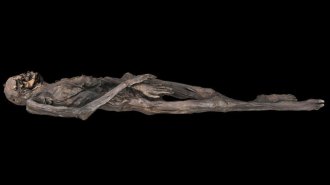The Original Cocoa Treat: Chemistry pushes back first use of the drink
- More than 2 years ago
It’s a triumph of bad housekeeping. Chemical analysis of residues from ancient Maya vessels that had been unwashed for 2 millennia has revealed that the pots held cocoa almost 1,000 years before its previously known earliest use.

Made from the beans of the tropical plant Theobroma cacao, cocoa was a favorite drink of ancient Maya and Aztec people in Mesoamerica. That helps explain why archaeologists have long referred to certain spouted Maya vessels as “chocolate pots,” even though these predated chemical evidence of cocoa consumption, says Terry G. Powis of the University of Texas in Austin.
Until now, the earliest leftovers of cocoa consumption were in residues from a Maya tomb in Guatemala from A.D. 460 to 480. The newly examined spouted vessels, from 600 B.C. to A.D. 250, were discovered at an archaeological site called Colha in Belize. Similar vessels date back as far as 900 B.C.
Analysis of 14 Colha vessels indicated that 3 contained theobromine and caffeine, markers for cocoa, says team member W. Jeffrey Hurst of the Hershey Foods Technical Center in Hershey, Pa. Archaeologists hadn’t previously cleaned these three pots because they have narrow necks, Powis adds. Unfortunately, archaeologists had washed the other pots, which might have once harbored the marker molecules. Powis, Hurst, and their coworkers describe their findings in the July 18 Nature.
Spanish explorers in the 1500s reported that the Mesoamericans mixed cocoa with water, maize, chili, and honey. Powis says he’s now interested in determining what ingredients the earlier Maya combined with their cocoa. He’d also like to discover the geography of ancient cocoa consumption.
These steps will be important to figuring out how and where the processing of cocoa drinks first developed, comments Patrick McGovern of the University of Pennsylvania Museum of Archaeology and Anthropology in Philadelphia. “Both honey and chocolate could be very important for the development of civilization and culture in the Americas,” says McGovern, who analyzed food and beverage residues from King Midas’ tomb (SN: 11/4/00, p. 296: http://www.sciencenews.org/20001104/bob1.asp). “Often these fermented beverages are right at the focal point of feasting and religious activities,” he says.







